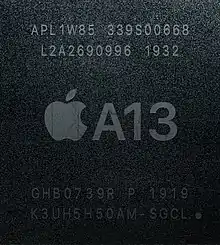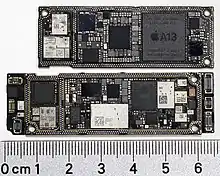Apple A13
The Apple A13 Bionic is a 64-bit ARM-based system on a chip (SoC), designed by Apple Inc.[2] It appears in the iPhone 11, 11 Pro/Pro Max[3] and the iPhone SE (2nd generation).[4] Apple states that the two high performance cores are 20% faster with 30% lower power consumption than the Apple A12's, and the four high efficiency cores are 20% faster with 40% lower power consumption than the A12's.
 | |
| General information | |
|---|---|
| Launched | September 10, 2019 |
| Designed by | Apple Inc. |
| Common manufacturer(s) | |
| Max. CPU clock rate | to 2.65 GHz |
| Architecture and classification | |
| Application | Mobile |
| Min. feature size | 7 nm |
| Microarchitecture | "Lightning" and "Thunder" |
| Instruction set | A64 – ARMv8.4-A[1] |
| Physical specifications | |
| Transistors |
|
| Cores |
|
| GPU(s) | Apple-designed 4 core |
| History | |
| Predecessor | Apple A12 |
| Successor | Apple A14 |
Design
The Apple A13 Bionic features an Apple-designed 64-bit six-core CPU implementing ARMv8.4-A[1] ISA, with two high-performance cores running at 2.65 GHz[5] called Lightning and four energy-efficient cores called Thunder. The Lightning cores feature machine learning accelerators called AMX blocks. Apple claims the AMX blocks are six times faster at matrix multiplication than the Apple A12's Vortex cores. The AMX blocks are capable of up to one trillion single-precision operations per second.[5]
The A13 integrates an Apple-designed four-core graphics processing unit (GPU) with 20% faster graphics performance and 40% lower power consumption than the A12's. Apple claims their A13's eight-core Neural Engine dedicated neural network hardware is 20% faster and consumes 15% lower power than the A12's.[3][5][6]
It is manufactured by TSMC on their 2nd generation 7 nm N7P (not to be confused with '7 nm+' or 'N7+'),[7] and contains 8.5 billion transistors.[8][9]
| SoC | A13 (7 nm enhanced) | A12 (7 nm) |
|---|---|---|
| Process Node | TSMC N7P | TSMC N7 |
| Total Die | 98.48 | 83.27 |
| Big Core | 2.61 | 2.07 |
| Small Core | 0.58 | 0.43 |
| CPU Complex (incl. cores) | 13.47 | 11.16 |
| GPU Core | 3.25 | 3.23 |
| GPU Total | 15.28 | 14.88 |
| NPU | 4.64 | 5.79 |
Products that include the Apple A13 Bionic
Gallery

See also
- Apple-designed processors, the range of ARM-based processors designed by Apple
- Apple M1
- Comparison of ARMv8-A cores
References
- "llvm-project/AArch64.td at llvm/master · llvm/llvm-project · GitHub".
- Hollister, Sean (September 10, 2019). "Apple says its new A13 Bionic chip has the fastest smartphone CPU and GPU ever". The Verge.
- "Apple announces A13 Bionic chip for iPhone 11". VentureBeat. September 10, 2019. Retrieved September 23, 2019.
- "iPhone SE - Technical Specifications". Apple. Retrieved April 15, 2020.
- Frumusanu, Andrei. "Apple Announces New iPhone 11, iPhone 11 Pro, & iPhone 11 Pro Max". AnandTech. Retrieved September 23, 2019.
- Wednesday, Malcolm Owen; September 11; 2019; PT, 12:35 pm. "More power with less: Apple's A13 Bionic is faster and more power efficient". AppleInsider. Retrieved September 23, 2019.CS1 maint: numeric names: authors list (link)
- Frumusanu, Andrei. "The Apple iPhone 11, 11 Pro & 11 Pro Max Review: Performance, Battery, & Camera Elevated". www.anandtech.com. Retrieved October 20, 2019.
- Zafar, Ramish (September 10, 2019). "Apple A13 For iPhone 11 Has 8.5 Billion Transistors, Quad-Core GPU". Wccftech. Retrieved September 11, 2019.
- Introducing iPhone 11 Pro — Apple Youtube Video, retrieved September 11, 2019
- Frumusanu, Andrei. "The Apple A13 SoC: Lightning & Thunder". AnandTech. Retrieved October 16, 2019.

